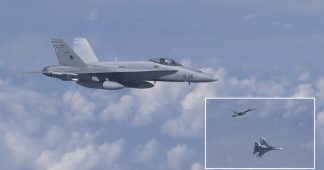The Russian-made medium-haul passenger jet MC-21 has received its “type certificate,” paving the way to mass production of the aircraft. The cutting-edge new market entrant has been plagued by sanctions and multiple delays.
The Irkut MC-21 is the first narrow-body, medium-haul passenger jet designed and built in Russia since the collapse of the Soviet Union. Conceived in the late 2000s, the plane is set to fill the niche that once belonged to the iconic 1970s Soviet Tu-154.
Jet designed with cutting-edge materials Modern materials have been widely used in the construction of the MC-21, with composites amounting to around 40% of its airframe, according to the aircraft’s manufacturers. This makes the plane significantly lighter compared to conventionally-built aircraft, as well as apparently more comfortable for passengers, allowing for more spacious aisles.
MC-21 manufacturer hit by US sanctions However, this innovation has proven to be a double-edged sword, becoming one of the main reasons behind delays in mass-production, despite the plane making its maiden flight in 2017. Back in 2018, the manufacturer of the wings, Russian company AeroComposit, was hit by the US sanctions. It was targeted over alleged participation in a Russian “aerospace military program,” despite having zero public contracts with the country’s armed forces. The concern was barred from importing raw materials, and was left unable to produce its orders for the plane.“The sanctions imposed on AeroComposit were nothing, but an example of unfair competition,” Roman Gusarov, the editor-in-chief of the Avia.ru website, told RT.
“ The firm poses no strategic or military threat to our foreign colleagues. It’s purely a civilian enterprise.” Boeing simply tried to “strangle its new emerging rival at its birth,” he insisted. The US planemaker and its European counterpart Airbus haven’t made new planes in this class for a long time he continued, only upgrading older models, while MS-21 “incorporates all the cutting edge technologies and therefore has a whole range of advantages compared to its foreign competitors,” Gusarov pointed out.
Russia starts production of banned composites The sanctions left the fate of the project uncertain, as fitting MC-21 with wings made out of conventional materials was deemed to be unfeasible. At the time, the country also lacked the technology to produce what was needed to make the plane’s wing locally. But the sanctions have ultimately given a jolt to local research and development, prompting the creation of the Russian-made composites needed to manufacture the wings.
Import-free jet production challenge accepted The MC-21 debacle has also prompted the manufacturers to strive for making the aircraft fully independent from imported systems. It also originally relied on the US-made Pratt & Whitney engines, as well as other imported avionic and electronic systems. The first MC-21 to be made completely out of domestically-developed components, or having a minimal amount of imported parts, is expected to emerge in the mid-2020s.
Airworthiness clearance granted to MC-21 “The changes to the type certificate, envisioning the use of a Russian composite wing and a Russian engine, is planned for 2022,” Russia’s Minister of Industry and Trade Denis Manturov has said.
Russian-made wing & jet engines incoming Both the homegrown composite wing and engines have been already produced, with tests of the systems still ongoing. An MC-21 fitted with Russian-made PD-14 engines made its maiden flight last December, and the engines were approved for mass production in February this year. Russia’s trade and industry minister, Denis Manturov, praised the PD-14 as a sign of the “maturity” of Russian science and the “high level” of development of the country’s aviation industry.
The designers and engineers, who received state support, were able to come up with “a very modern and efficient engine,” the minister added, adding that “neither the USSR nor Russia had anything like this in the last 40 years.” An MC-21 fitted with domestically produced parts has already made its first flight, however. Last weekend, the manufacturer announced that a test MC-21-300 jet with a Russian-made composite wing took off from an airfield in Irkutsk, and that the flight was normal.











